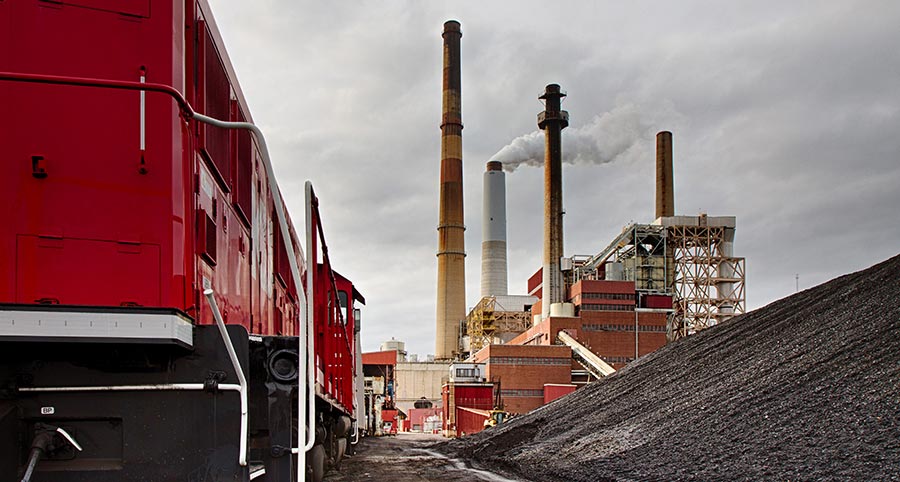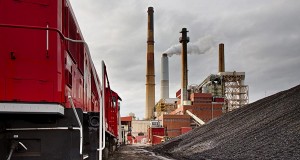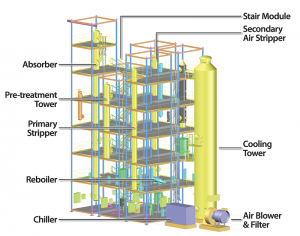July 21, 2014 – I remain skeptical about the economics of industrial technologies for carbon capture. Almost every project started has been heavily subsidized by government. But for the operators without government subsidy there seems to be no return on investment. First of all, all existing industrial carbon capture technologies are expensive to implement. Second, once installed in the outflow processes of a typical coal-fired power plant they require additional energy to operate which means the utility actually has to burn more coal to capture the carbon.
Enter the University of Kentucky and its Center for Applied Energy Research. At the E.W. Brown power plant (seen below), located in Harrodsburg, Kentucky, a new technology for carbon capture may prove to be an industry game changer.
Typical carbon capture processes recover the CO2 from the outflow stack in a power plant. This is done by spraying a liquid solvent into the outflow. The solvent traps CO2. As much as 98% of the gas can be scrubbed from the chimney emissions this way. But what to do with the CO2-solvent mix.
Carbon capture systems are designed to reverse the process to restore the solvent while releasing the CO2 into a trap of some kind. That trap is usually a storage tank. From there added energy is needed to compress and pump the carbon underground. If located over a stable sandstone formation, the captured carbon can begin to bind with the rock turning it into limestone which permanently traps the carbon. These processes produce waste heat as a byproduct and because they need additional energy require the plant to burn more coal.
The University of Kentucky process, however, attempts to integrate carbon capture into the power plant, rather than have it as an add-on process at the end point. The schematic below shows the carbon capture part of the E.W. Brown plant installed in Harrodsburg. The heat generated during carbon capture is in itself captured for reuse. A second step in the interaction between solvent and the CO2 produces even higher rates of carbon removal.
The 2 Megawatt unit cost $19.5 million U.S. and will be operated by LG&E and KU ODP. Other project participants include the University of Kentucky, Kentucky Power, Duke Energy, and the U.S. Federal Department of Energy, the latter contributing $15 million to the project.
I truly hope this new carbon capture technology succeeds. But would it have legs if it weren’t for a 75% subsidy from the federal government? I state this because that seems to be the only reason private enterprise engages in carbon capture and sequestration projects – when they get federal, state, or in the case of Canada, provincial money to offset potential losses.
If a carbon tax were implemented, however, instead of the cash carrot incentive which is the present practice, power utility companies would be compelled to implement carbon capture or pay for the pollutants they discharge. But here in North America only a few jurisdictions have legislated a carbon tax, a critical mistake by our governments if they want to make a serious dent in our carbon footprint.























From an engineering perspective, the least bad and most cost effective way to sequester atmospheric carbon is through tropical rain forest photosynthesis. It makes no difference to the global atmosphere whether the carbon is generated and sequestered in Kentucky or whether the carbon is generated in Kentucky and sequestered in Brazil. The Amazon River dumps an average of 200,000 cubic meters/sec of fresh water into the Atlantic Ocean. All that wasted fresh water could in principle be used to grow plants and sequester carbon. All the carbon emissions in Kentucky, or for that matter all of North America, could be sequestered in Brazil’s huge tropical rainforest swamp lands. All it takes is fast growing plants, sun, rain, big bulk harvesters, and large barges to haul the organic material down river and out to sea. Huge metal nets and cable conveyers would sink the biomass to a depth of approximately 1000 feet, where the pressure would be 435 PSI, enough to compress the junk biomass to a density below 0.99. Then the material would continue to compress and sink to the abyssal sea floor some 14,000 feet below. Alternatively, and at even lower costs, huge artificial peat bogs could provide long-term carbon storage.
I ran rough numbers on such a project a decade ago. Looks like large-scale costs should be below $7/ton of carbon permanently sequestered in the abyssal depths. Water temperatures at that depth are near freezing and below the methane hydrate formation point, hence most methane produced through gradual decomposition would stay in the depths. If the developed industrial world is actually serious about carbon sequestration, it just needs to go to Brazil and create 500,000 well paying jobs for illiterate low-skill jungle weed growers. Let the CO2 emitting nations tax their CO2 emissions at $15/ton and pay Brazil $15/ton to inter it in the deep ocean. None of the stack capture schemes will ever work at even $30/ton. $15/ton is affordable, and actually dirt cheap, but I think it doubtful that India and China are going to pay an extra $15/ton for coal. If you can’t make that work, you can’t make anything work.
One needs to think about this problem in terms of scale of huge copper and coal mining heavy equipment. Let global carbon emitters pay for global photosynthetic sequestration.
I agree with you that we humans should be protecting natural carbon sinks as far more effective means of dealing with CO2.